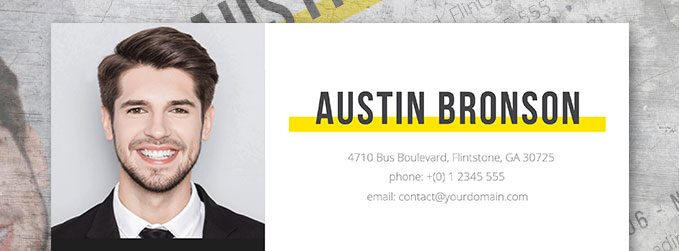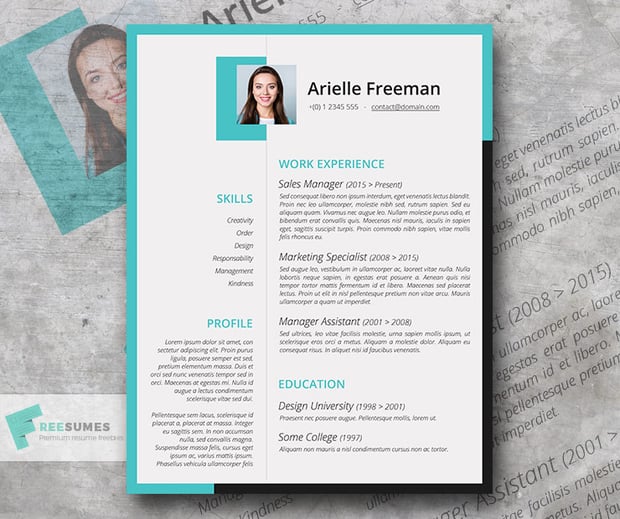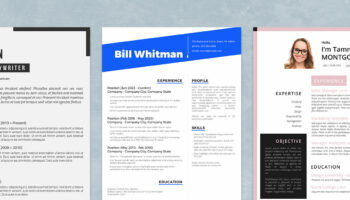Resume writing and the feeling of overwhelm come hand in hand. Loss at where to begin can certainly discourage you from getting started — and delays your timeline to getting a great new job you deserve.
So pull yourself together and start fleshing out the main sections of your resume. Just which one are these? This guide will explain.
What Are the Main Sections of a Resume?
The standard resume has three main sections — header, work experience, and education. That’s the essentials you should cover. Optionally, you can also expand the header area to accommodate a resume summary or resume objective statement. For some professions, adding two extra resume sections — references or security clearance — also makes sense.
So essentially, the minimum number of sections to include on a resume is three. The maximum number to look good on one page is five.
How Do You Structure a Resume?
A resume has to provide a succinct, skimmable snapshot of your professional abilities.
To achieve that goal, you should clearly distinguish between each section using headings or design elements such as bullet points, color blocks, etc.
As well, your texts should be logically grouped under a descriptive subhead. So that the reader could instantly understand where to find the details they need — be it your hard and soft skills or major work accomplishments.
The two common resume formats for achieving the above are a chronological resume and a functional resume. The chronological resume is a more popular option upon HR executives.
Below we further explain which resume sections should be on your chronological resume.
Create Resume Header
A resume header is the topmost area of the page, where you list your full name and contact details, plus a photo (optional).

From the Contrast resume template
These are the must-have basics to cover when writing a resume.
But since a header is the first thing an employer will see you can make a bigger impact by expanding the resume header with extra details.
For example, you can also include:
- A professional tagline — a one-liner explaining what you do e.g. Award-winning publicist for authors. Former clients include Torrey Peters, Rachel Yoder, and Tove Ditlevsen.
- A resume objective statement — a longer paragraph explaining what you would like to achieve in this position. This option is more suitable for recent graduates or people working in academia.
- A resume summary — similar in length to an objective, a resume summary offers a short preview of your core competencies and intriguing accomplishments.
Learn more about writing and designing a show-stopping resume header.
Add a Work Experience Section
A resume work experience section is the linchpin of your entire document. It pulls together the bulk of your professional experience into a short, polished synopsis — one that a busy HR can skim through to understand your levels of qualifications.
Similar to others, this resume section should be constructed with readability in mind. To help you nail that do the following:
- Write all the employer names first. As a rule of thumb you should include a) the most recent positions b) and the most relevant ones.
- Add employment dates. Typically, you have to add a “month-year”. But if you have some employment gaps to cover up, just list the years.
- Put down your job titles. If your company used some specific internal naming titles (like L4 Software Engineer), go for a wider known term e.g. Junior Software Engineer to prevent confusion.
- List your responsibilities and impact. This is the trickiest part. Remember: you have to keep things short and sweet. So there’s no need to list all of your duties. To figure out which ones are worth a mention, go back to the job description. Check what requirements it mentions. Then use these “keywords” in your copy. But don’t just say what you did — mention the results you’ve achieved!
- Add achievements, promotions, and other recognitions. For each job entry, try to highlight 1-2 achievements that showcase your expertise. As a rule of thumb, you should aim for 5 bullet points for each work entry. For each squeeze in 1-2 achievements and use the rest for duties.
To better understand how to write an impactful work experience section, browse our immense collection of resume examples. We have most career levels covered — from entry-level to executive — across an array of industries and professions!
Round-Up with an Education Section
Unless you are a recent graduate keep your resume education section minimal. List the last degree you’ve obtained, your major/minor, and your graduation year.
Use the extra space to mention other relevant professional certifications you have. Now that doesn’t mean listing every e-course you’ve consumed over the past months. Be selective and mention training that is relevant to the position you are after.
For example, if you are after a project management position it’s cool to say that you are a Certified Scrum Master or Agile Coach. But don’t include a Product Management seminar you’ve attended when the advertised position mentions nothing about that. It is a bit you can keep for your cover letter or a job interview.
Now, what if you are fresh out of college and don’t have that jumbo-sized work experience section?
Then, by all means, do provide more details about your education. As long as your coursework and extracurricular activities are relevant to the position you are after, do bring them up.
For example, if you are a recent Media Studies graduate, working on a resume for a PR position, you can format your education section in the following way:
Education
Hudson University (June 2021)
Bachelor of Arts in Media Studies
Emphasis: Public Relations
GPA: 3.8
Research paper study: “The Role of Influencer Marketing in Shaping Public Perception of Beauty Brands: Quantitative Study”
Courses taken:
- Journalism and Media Relationships
- Digital Marketing: Basic and Advanced Studies
- Global digital cultures studies
- Fact-checking and fake news analysis
Extracurricular activities:
- Worked as a social media coordinator and media assistant for the Admissions Office
- Associate Editor of “Hudson’s Literary Digest” magazine.
Consider Optional Sections
The above three sections of a resume are the base you need to cover.
Once you are done, give your document another look. Do I have extra space left? Will expanding my work history make things repetitive? Did I miss any requirements from the job ad?
If you said “Yes” to either of the above, you’d probably benefit from adding one of the following extra sections for your resume.
Skills
If you’ve decided against having a resume summary of your main skills in the header, but now realize that you didn’t list all your “hireable” qualities, fit those into a dedicated skills section in the sidebar.

From the Colors and Shapes Creative Resume Template
Hobbies and Interests
The debate continues whether to list hobbies and interests on a resume. Or take: if you are applying to a less formal organization and have some space left, go for it.
Sharing personal tidbits help the reader better understand what type of a person you are and whether you’ll be a good cultural fit with the rest of the team.
Your hobbies can also be complementary to your core competencies and extra as extra keywords for your resume. For example, if you are applying to work as a Sales Manager at a company selling hiking gear, mentioning that you are a keen climber yourself will definitely win you some points!
References and Recommendations
For some professions, personal and professional references go a long way. These include many academic positions, jobs in the medical field, and employment propositions in regulated industries such as defense or security.
So if the job ad explicitly asked to prove a certain number of references, add them to your resume.
We have a separate guide explaining how to list references on a resume. Check it out!
Work Authorization and Security Clearance
Likewise, some private sector and federal jobs require you to possess a special work authorization and/or security clearance.
This is a frequent requirement for independent contractors and consultants, hired by government agencies. But this may be also the case for anyone looking into judicial positions, working in the police units, or, in some cases, employment with telecom companies.
If you have been asked to provide special work authorization and security clearance for your current position, chances are that your next employer may also want to know your status. So mention that briefly at the end of your resume.
Still Struggling? Get a Free Resume Template
Nailing your resume sections structure isn’t easy. Especially, if you aim to fit everything into one page. So rather than starting with a blank page, try one of our free resume templates. If you don’t have Microsoft Word installed, try our set of optimized resume templates for Google docs instead. Each option has all the main resume sections fleshed out with readability in mind.
You can also choose among an array of options like templates with a sidebar or full-page ones; without or with extra space for fitting a resume summary. With all necessary resume sections predesigned, all you are left to do is fill in the blanks!
FAQs about Resume Sections
Here are several other common questions about sections for resumes with answers to them.
What is the best resume layout?
The best resume layout is a chronological resume, opening with a header section, followed by a resume or skills summary (optional), then a work experience section, and education. The layout itself can be full-page or with a sidebar. Both options are viewed favorably by employers.
What is the most important part of a resume?
The most important section of your resume is the work experience section since it provides the most context about how you’ve acquired different skills and qualifications. It also helps the employer understand which industries you’ve worked for in the past. So do spend the most time on writing it out. For each position, mention both your duties and accomplishments. Quantify the results whenever you can to show just how much of an impact you can achieve in the organization you’d join.
What are four things a great resume shows employers?
A stellar resume communicates the following four things to the employer:
- Your level of seniority
- Your technical core competencies and most marketable skills
- The results and impacts you’ve made in the past roles
- Personal traits and qualities, reflected by your soft skills.






